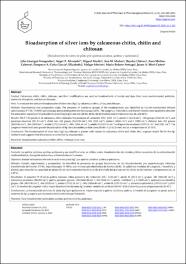“Bioadsorption of silver ions by calcareous chitin, chitin and chitosan“

Ver/
Descargar
(application/pdf: 571.8Kb)
(application/pdf: 571.8Kb)
Fecha
2023-01-02Autor(es)
Jáuregui-Nongrados, John
Alvarado, Angel T.
Mucha, Miguel
Muñoz, Ana M.
Chávez, Haydee
Molina-Cabrera, Aura
Cuba-García, Pompeyo A.
Melgar-Merino, Elizabeth J.
Bolarte-Arteaga, Mario
Mori-Castro, Jaime A.
Metadatos
Mostrar el registro completo del ítemResumen
“Context: Calcareous chitin, chitin, chitosan, and their modifications are used as bioadsorbents of metals and dyes that cause environmental pollution,
endocrine disruption, and human diseases.
Aims: To evaluate the selective bioadsorption of silver ions (Ag+
) by calcareous chitin, chitin, and chitosan.
Methods: Experimental and prospective study. The presence of functional groups of the bioadsorbents was identified by Fourier-transformed infrared
spectroscopy (FT-IR), 1H-NMR spectroscopy and scanning electron microscopy (SEM). The Langmuir, Freundlich, and Elovich models were applied to describe
the adsorption capacity of bioadsorbents according to granule size (20-40, 40-60, 60-80 meshes) and temperature (10, 20, and 30°C).
Results: The FT-IR spectrum of calcareous chitin indicates the presence of carbonate (CO3
=
1420 cm-1
), amide III (1313 cm-1
), –OH groups (3441.90 cm-1
), and
pyranose structure (952.83 cm-1
); chitin has –OH groups (3441.90 cm-1
), NH (3268 cm-1
), amide I (1654 cm-1
) and II (1559 cm-1
); chitosan has –OH groups
(3419.90 cm-1
), –NH (3200 cm-1
), amide I (1712.18 cm-1
), –NH2 (1654.46 cm-1
), amide III (1317.11 cm-1
) and pyranose structure (1070.12 cm-1 and 1031 cm-1
). The
Langmuir model indicates greater bioadsorption of Ag+
ions at smaller particle sizes (60-80 = 0.25-0.18 mm) and at a temperature of 20-30°C.
Conclusions: The bioadsorption of silver ions (Ag+
) by chitosan is greater with respect to calcareous chitin and chitin; the Langmuir model fits for the Ag+
isotherm and suggests that the process is controlled by physisorption. “
Colecciones
- SCOPUS [380]

